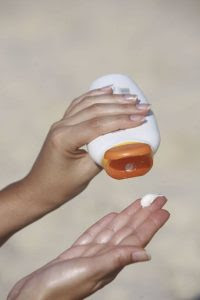
There’s a good chance you wear sunscreen to the beach to protect your skin, but do you wear it every day? Below you’ll discover why daily sun protection could be the hero in your battle against premature aging. And you’ll learn how to apply sunscreen with makeup, so you never have to choose between a flawless face and adequate sun protection again.
Protecting Your Face From The Sun’s Harsh Rays
While many people know they should wear sunscreen to help protect against abnormal changes to their skin that may put their overall health at risk — there are some surprising benefits to wearing sunscreen daily from an aesthetic point of view as well.1
Sunscreen may help with the appearance of skin aging. One study found after following participants for 4.5 years, those who wore sunscreen daily and reapplied as instructed showed 24% less visible signs of premature aging — a loss of elasticity, spotting, and wrinkling — than those who didn’t follow a daily sunscreen routine.2
Another study following participants for a year found the use of daily facial sunscreen helped improve not only the texture of their skin but the appearance of uneven pigmentation.3,4
What do these studies mean for you? It may never be too late to start reaping the benefits of daily sunscreen use, especially if there is potential that its use may help reduce the damage the sun’s strong UV rays do to your skin.
Understanding Broad-Spectrum Protection
So, you’ve committed to wearing sunscreen every day, but which one is right for you? To begin with, you’ll want a sunscreen that provides broad-spectrum protection. This means it protects your skin from both UVB and UVA rays.
- UVB rays affect the top layer of skin cells. They are the rays most responsible for sunburn and blistering, as well as the development of abnormal skin cell growth.
- UVA rays affect the inner cells of the epidermis and dermis. They are most associated with signs of premature aging, but these rays can also contribute to abnormal skin cell growth.5
What To Know About SPF Levels
Sun Protection Factor, better known as SPF, can be explained simply. If you use a product labeled SPF 30 precisely as directed, it would take your skin 30 times longer to redden (that is, to burn) than if you didn’t apply sunscreen at all.6
So what level is right for you? Here’s some general guidelines:
- If you are indoors nearly the whole day with only short periods of sun exposure — wear SPF 15 or higher.
- Outdoors a lot of the day and/or when the sun is strongest — wear SPF 30 or higher (and look for a sunscreen that is water-resistant).
- Think you can skip SPF on overcast or cloudy days? Not so fast — nearly 80% of the sun’s UV rays still make it to earth — and that means, to you.7
If you’re still not sure which level of SPF is right for you talk to your dermatologist.


Choosing The Right Ingredients For You: Physical Barrier Vs. Chemical Sunscreen
Consumers have so many options today with SPF in products — from moisturizer to foundation to setting spray, but not all sunscreens are the same. They basically breakdown into two camps:
Physical sunscreens(mineral sunscreens)create a barrier on top of your skin by reflecting the sun’s rays. The two most common active ingredients in physical sunscreens are the minerals zinc oxide and titanium dioxide.8
Chemical sunscreens absorb into your skin, rather than sit atop it, and then they absorb the rays and convert them into heat that’s released from your body. The most common active ingredients you’ll see include avobenzone, oxybenzone, and octinoxate.9
Note: Have sensitive skin? Some people may find physical sunscreens less irritating.10
When And How To Include SPF Into Your Skin Care And Makeup Routine

The first question you may have is whether you have to use a separate sunscreen if your makeup already has SPF in it. The simplest answer is yes — because makeup products are not always a reliable source for an even application of SPF. Also, makeup easily comes off.
One great aspect of wearing SPF under your foundation, BB cream, or CC cream is that it acts as an amazing primer. Something to note here though, it’s best to let your sunscreen set on your face for a few minutes before beginning the rest of your routine.11
You should expect to use a nickel-sized dollop of sunscreen to adequately cover your whole face — and don’t forget your ears, neck, and chest too.12
This is not to say you shouldn’t bother with moisturizer or makeup products with added SPF — they’re great options too since you’re layering up on protection. One interesting study found, however, that participants missed more of their face when applying a moisturizer with SPF compared to a sunscreen that was not also a moisturizer.13 Something to keep in mind when applying product.
How To Reapply Sunscreen With A Face Full Of Makeup
It’s recommended that sunscreen be reapplied every two hours if you’re outdoors or exposed to the sun throughout the day indoors (i.e., sitting in front of a window).14
For anyone who wears makeup, that can seem like quite a challenge — but it doesn’t have to be. Here are your options:
- Setting Spray with SPF – Just after you have touched up your makeup, go over your face with an SPF setting spray. You’ll get a flawless finish with added sun protection.
- SPF Powder – Powder not only gives you the opportunity to reduce shine, but you can build on your sun protection. Depending on your needs, there are both tinted and translucent powder options, as well as loose powder in portable sticks and pressed powder in compacts.15
There you have it — adequate protection from the sun’s harsh rays without disturbing your makeup.
Skin Care, Sun Protection, And Makeup Working Together
You never have to choose protecting your skin from the sun over a fabulously contoured nose or highlighted cheeks again. Your skincare and makeup routine can easily make way for a quick sunscreen application — and your skin will thank you years from now.




